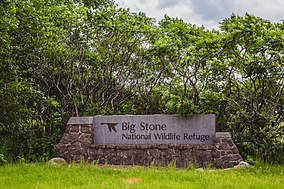| Big Stone National Wildlife Refuge | |
|---|---|
IUCN category IV (habitat/species management area) | |
 An entrance sign marker at Big Stone National Wildlife Refuge | |
Map of the United States | |
| Location | Big Stone County, Lac qui Parle County, Minnesota, United States |
| Nearest city | Ortonville, Minnesota |
| Coordinates | 45°14′31″N96°20′49″W / 45.242°N 96.347°W [1] |
| Area | 11,586 acres (46.89 km2) |
| Established | 1975 |
| Governing body | U.S. Fish and Wildlife Service |
| Website | Big Stone National Wildlife Refuge |
Straddling the headwaters of the Minnesota River in west-central Minnesota, Big Stone National Wildlife Refuge is within the heart of the tallgrass prairie's historic range. Today, less than one-percent of tallgrass prairie remains.
Contents
- Geography and geology
- Geology
- Climate
- History
- Wildlife and ecology
- Flora
- Fauna
- Recreation
- See also
- References
Big Stone Refuge serves as the "keeper of the prairie" by working to maintain and restore native prairie habitat while providing optimum nesting cover for waterfowl and other grassland nesting birds. The refuge contains 11,521 acres (46.62 km2): 1,028 acres in Big Stone County and 10,493 acres (42.46 km2) in Lac qui Parle County. The refuge is located in Minnesota's 7th congressional district.
The primary refuge purposes stated in authorizing documents are flood control, recreation, and fish and wildlife conservation. The refuge's principal objective is to provide optimum nesting cover for ground-nesting waterfowl production.
